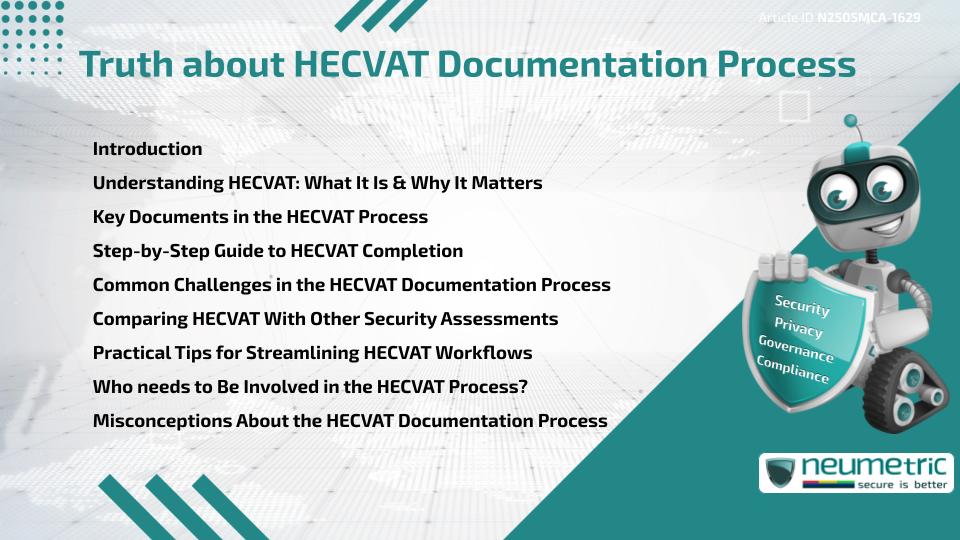Table of Contents
ToggleIntroduction
The truth about HECVAT documentation process is that while it appears complex at first, it is a systematic & achievable task designed to improve Cybersecurity transparency. The Higher Education Community Vendor Assessment Toolkit [HECVAT] was developed to support Colleges & Universities in evaluating the security postures of their Third Party Service Providers. As more educational Institutions depend on Cloud-based Vendors & digital services, understanding this documentation process is not just helpful—it is essential.
Understanding HECVAT: What It Is & Why It Matters
HECVAT is a structured questionnaire Framework developed by the Higher Education Information Security Council [HEISC]. It is used to assess Vendor Risk across Data Security, Privacy Controls & Compliance Requirements. The core goal is to ensure Third Party Software & Services meet acceptable Security Standards within higher education settings.
The truth about HECVAT documentation process lies in its intent: it is not meant to burden Vendors but to create a shared understanding of Risk. When implemented correctly, HECVAT streamlines communication between Institutions & Vendors & reduces redundant Audit processes.
Key Documents in the HECVAT Process
There are several versions of HECVAT, each tailored to different levels of Vendor engagement:
- HECVAT Full: For services that handle sensitive or critical institutional information.
- HECVAT Lite: A shorter version for low-Risk services.
- HECVAT On-Premise: Used when Software is installed on institutional servers.
- HECVAT Baseline: Includes standard controls anticipated across all services.
The truth about HECVAT documentation process is that selecting the correct version is half the job done. Using the wrong version may lead to unnecessary complications or missed Risks.
Step-by-Step Guide to HECVAT Completion
While Institutions may customise the process, here is a general flow:
- Vendor Selection
- Determining HECVAT Scope
- Sending the Questionnaire
- Vendor Response Collection
- Review & Validation
- Approval & Onboarding
The truth about HECVAT documentation process is that it is repetitive, but not difficult. With proper training & collaboration, teams can manage it efficiently.
Common Challenges in the HECVAT Documentation Process
Some Vendors & Institutions face delays due to:
- Lack of awareness about HECVAT requirements
- Incomplete responses by Vendors
- Manual review bottlenecks
- Unclear Data Sensitivity classifications
One of the biggest truths about HECVAT documentation process is that delays often arise not from the form itself but from the people involved. Coordinating roles, responsibilities & expectations is key.
Comparing HECVAT With Other Security Assessments
In contrast to standard Security Assessments like ISO 27001 or SOC 2, HECVAT is specifically designed for the higher education sector.
| Feature | HECVAT | ISO 27001 | SOC 2 |
| Education-specific | Yes | No | No |
| Control Framework | Pre-defined | Flexible | Flexible |
| Cost to Vendor | Low | High | High |
| Depth of Assessment | Moderate to High | High | High |
The truth about HECVAT documentation process is that it provides a balance between cost-efficiency & effectiveness for academic settings.
Practical Tips for Streamlining HECVAT Workflows
- Create an internal HECVAT guidebook for your team
- Pre-qualify Vendors using the Lite version before scaling up
- Automate reviews using security tools where possible
- Maintain a repository of reviewed HECVAT responses
- Standardise communication templates
Who needs to Be Involved in the HECVAT Process?
The documentation process works best when roles are clearly defined. Key Stakeholders include:
- IT Security Teams – assess Risks & review responses
- Procurement Officers – ensure contractual alignment
- Data Privacy Officers – evaluate Compliance elements
- Vendor Representatives – complete & clarify questionnaires
The truth about HECVAT documentation process is that it’s a team sport. Siloed efforts only lead to duplication & frustration.
Misconceptions About the HECVAT Documentation Process
Some common myths include:
- “Only big Vendors need to complete HECVAT”
- “It’s just a paperwork formality”
- “Completing HECVAT guarantees Compliance”
None of these are true. The truth about HECVAT documentation process is that it’s an evaluation tool, not a certification & it helps decision-makers reduce Cybersecurity Risk.
Conclusion
The HECVAT process, though often misunderstood, is essential for maintaining trust & security in the higher education ecosystem. The truth about HECVAT documentation process is that with clear guidance, team collaboration & a focus on simplification, it becomes a powerful tool for Risk Management.
Takeaways
- HECVAT is a Standard Vendor Risk tool tailored for higher education.
- There are several versions of HECVAT that correspond to the sensitivity of vendor data.
- Delays often stem from unclear roles or incomplete submissions.
- It’s not a Compliance checklist but a Risk communication tool.
- Streamlining the process helps Institutions & Vendors alike.
FAQ
What is the truth about HECVAT documentation process in Vendor Assessments?
It is a practical, structured tool that evaluates Vendor security posture & facilitates trust between Institutions & third parties.
Do all Vendors need to complete a HECVAT?
No, only those handling sensitive institutional data typically need to. Nevertheless, certain institutions may require it for all digital services.
Is HECVAT mandatory for higher education Vendors?
It is not legally mandatory, but many universities make it a requirement for software or cloud providers before onboarding.
How long does it take to complete HECVAT?
Depending on the version & preparedness of the Vendor, it can take anywhere from a few hours to several days.
What are the biggest challenges in HECVAT documentation?
Common issues include incomplete answers, lack of security knowledge & misalignment between the Vendor & institutional expectations.
Can a HECVAT response replace a SOC 2 Report?
No, they serve different purposes. A SOC 2 Report is an Audit, while HECVAT is a self-assessment tailored for higher education needs.
Who reviews the completed HECVAT forms?
Typically, IT security teams & procurement or Compliance officers review the responses before final approvals.
Need help?
Neumetric provides organisations the necessary help to achieve their Cybersecurity, Compliance, Governance, Privacy, Certifications & Pentesting goals.
Organisations & Businesses, specifically those which provide SaaS & AI Solutions, usually need a Cybersecurity Partner for meeting & maintaining the ongoing Security & Privacy needs & requirements of their Clients & Customers.
SOC 2, ISO 27001, ISO 42001, NIST, HIPAA, HECVAT, EU GDPR are some of the Frameworks that are served by Fusion – a centralised, automated, AI-enabled SaaS Solution created & managed by Neumetric.
Reach out to us!


